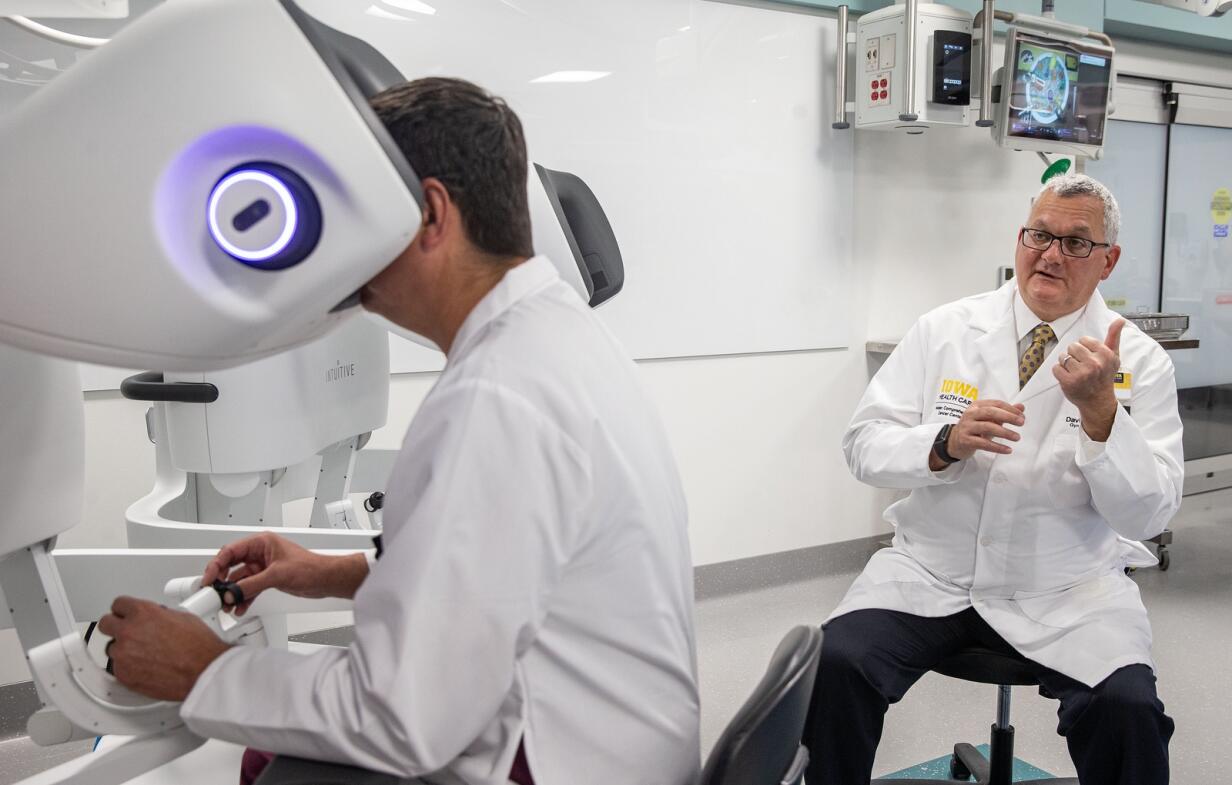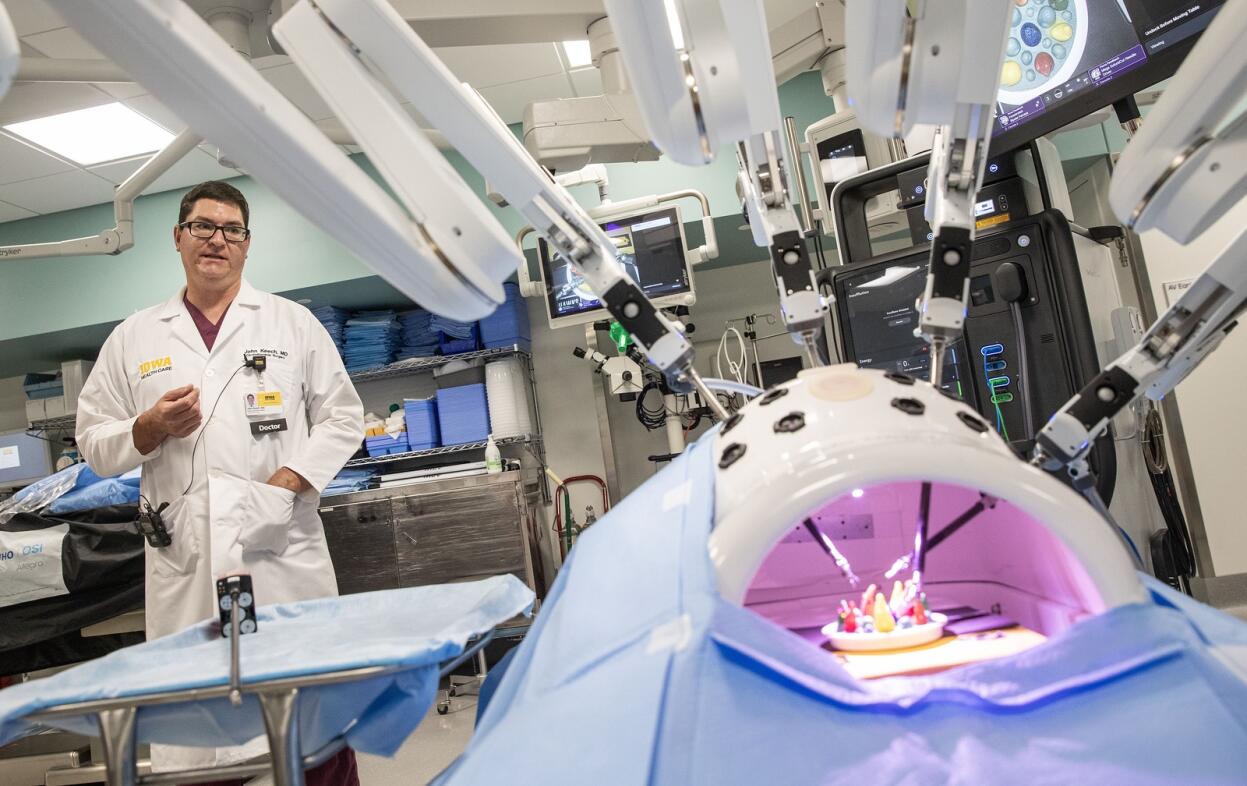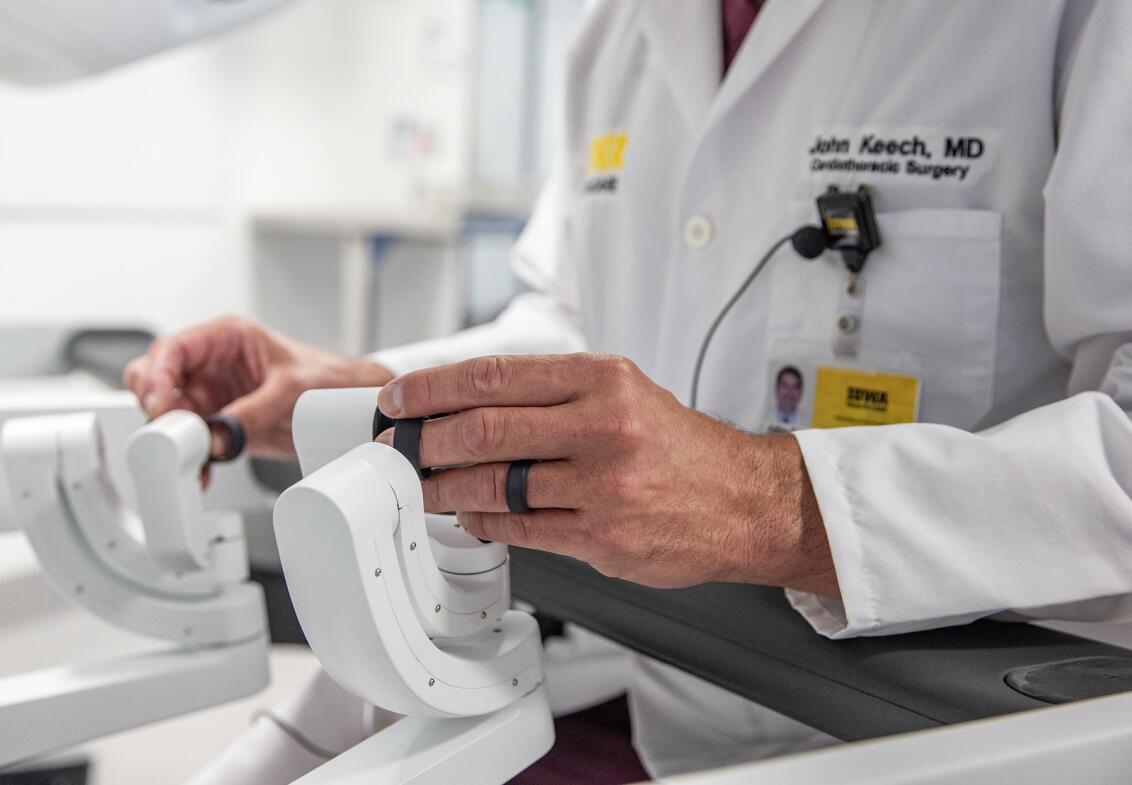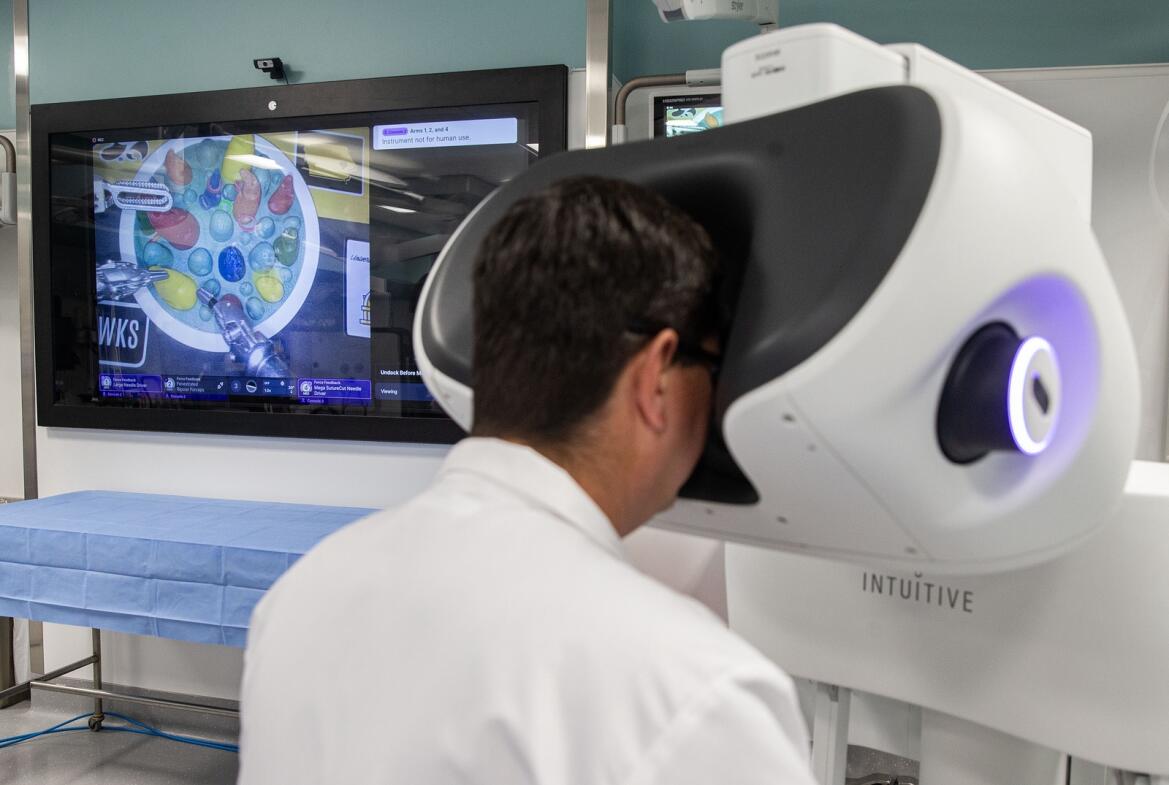IOWA CITY — Sitting in a console reminiscent of a virtual reality video game involving joysticks and foot pedals and 3D, high-definition viewing through immersive lenses, University of Iowa cardiothoracic surgeon John Keech last week manipulated with precision the tiny wrists of robotic arms — placing and replacing colorful bands on and off small formations set up inside a mock patient to his back.

Arms on the da Vinci 5 surgical robot are used on a toy to show how precise they are during a demonstration in the robotics lab at the University of Iowa Hospital in Iowa City on June 9, 2025. The hospital has acquired three of the da Vinci 5 robots and say the advanced technology will attract doctors from around the Midwest. (Savannah Blake/The Gazette)
Although just a demonstration, Keech and a growing raft of UI Health Care surgeons increasingly are performing minimally-invasive, robotic-assisted surgery in real patients.
And by bringing onto campus this month three of Intuitive Surgical’s new da Vinci 5 robotic-assisted surgery systems — making UIHC the first in Iowa to have the “most advanced and integrated robotic surgery system ever” — the university could double its robotic-assisted procedures and boost its training opportunities for resident surgeons.“This is the future of surgical treatment for the majority of patients that are coming to the university who need a procedure,” UIHC gynecologic oncologist David Bender said, reporting the da Vinci 5s will add to the three da Vinci Xi models UIHC has been using since 2015.
Touting the technology’s capacity to deliver the same quality with less discomfort, less blood loss, lower infection rates, along with shorter hospital stays and faster returns to work, Bender said the new machines expand the opportunity for UIHC patients to ask, “Am I a candidate for minimally-invasive surgery? And if so, am I a candidate for a robotic procedure?”
Not every patient will be, according to Bender, who also serves as the university’s medical director of robotic surgery. And not every surgery is right for minimally-invasive techniques.
“But with this technology, what we've been able to do for patients is really revolutionary,” he said. “And the University of Iowa is at the cutting edge now, both in delivering the care and training the next generation of surgeons to do it.”

Gynecology oncologist and UI Director of Robotics David Bender answers a question about the da Vinci 5 surgical robot at the University of Iowa Hospital in Iowa City on June 9. (Savannah Blake/The Gazette)
Another 1,000 cases annually
Since the U.S. Food and Drug Administration first approved California-based Intuitive Surgical’s da Vinci Surgical System in 2000, the robots have become routine nationally for laparoscopic soft-tissue procedures. Last year alone, the company reported 2.63 million surgeries nationally were performed with its da Vinci systems — up 17 percent from 2023, according to the American Hospital Association.
UI Health Care has had every generation of Intuitive Surgical robot dating back to 2002, Bender said, acquiring in 2015 the Xi model — which was the latest version before the FDA in March 2024 cleared the da Vinci 5 for use.
“Da Vinci 5 builds on Intuitive’s da Vinci Xi’s highly functional design, which surgeons and care teams around the world have used in more than 7 million procedures to date,” the company reported.
UIHC surgeons have been performing about 350 operations a year per Xi model.“So we were somewhere around 1,100 to 1,200 cases per year on three systems,” Bender said.“ It is used by general surgery, cardiothoracic surgery, urology, gynecology, colorectal surgery, cardiac surgery, pediatric surgery, otolaryngology — all of those programs have a minimally-invasive robotic component to their surgical training now.”
The three new da Vinci 5s will expand UIHC’s robotic-surgery capacity by about 1,000 procedures a year.
“We anticipate that with the three new systems, we'll be able to do a minimum of 300 to 400 cases per extra system,” Bender said. “And the increased availability of access to the units allows more surgeons to be brought into the mix and allows them to deliver the care to their patients.”
UIHC officials didn’t provide The Gazette with a cost for each of the new da Vinci 5 machines or the previous models still in use but said, “We didn’t pay any up-front cost for the three new dv5s.”
“We have an agreement with the company where it's paid per procedure, versus paying outright for the capital equipment,” according to spokeswoman Laura Shoemaker.
The university also didn’t provide The Gazette with copies of its agreements with Intuitive in time for this story.
Science journals and trade publications years ago reported acquisition costs of a da Vinci could top $2.5 million depending on the model, configuration, and location — excluding indirect costs like annual service fees or recurring costs of instruments and accessories.
The Decorah-based Winneshiek Medical Center, or WinnMed, earlier this month approved a capital asset purchase to lease a daVinci 5 surgical system at $384,000 annually over seven years — amounting to $2.7 million.
Other health care systems across the region and in Iowa have various da Vinci models, including MercyOne locations in Des Moines and Davenport, and St. Luke’s Regional Medical Center in Sioux City.

Cardiothoracic surgeon John Keech talks about the new da Vinci 5 robot in the robotics lab at the University of Iowa Hospital in Iowa City on June 9. The hospital has added three of these machines, which will allow it to perform nearly 1,000 more surgeries a year. (Savannah Blake/The Gazette)
‘Significant degree of control’
UIHC surgeons started using the new da Vinci 5 machines June 2 — with three separate bariatric operations.
“When we were working on three systems among all those different fields that I mentioned, it became quite challenging, almost like a Tetris puzzle, trying to get people scheduled with (operating room) access, as well as robotic access,” Bender said.
In announcing FDA approval for its new da Vinci 5s last year, Intuitive Surgical boasted more than 150 enhancements, including improved accuracy and “first-of-its-kind force-sensing technology.”
“I think one of the biggest advantages is the ability to feel what you're doing inside the patient,” UIHC surgeon Keech said of the da Vinci 5. “All the previous generations did not have the ability where you could feel what the robot was doing inside. They now have included that technology — where when you're grabbing something inside the patient, you can feel the tension, which is a huge advantage in a lot of different circumstances.”
The new console also is simplified, less bulky, and easier to control, Keech said.

Cardiothoracic surgeon John Keech uses the controller on the da Vinci 5 robot during a demonstration in the robotics lab at the University of Iowa Hospital in Iowa City on June 9. Keech says the use of robots in surgery allows for precise procedures. (Savannah Blake/The Gazette)
“The newest generation, I think, adds more flexibility to the surgeon at the console, where we can control now pretty much most aspects of the operation while we're sitting at the console,” he said.
The da Vinci 5s include three primary components:
- The “patient cart” holds the camera and robotic arms, with instruments the surgeon can control from their console;
- The “surgeon console,” sitting apart from the cart, includes a magnified 3D vision system and controls doctors use to bend and rotate “tiny-wristed” instruments on the robotic arms while performing the procedure;
- And the “vision cart” facilitates communication between components and supports the 3D high-definition visions system.
“I really liken it to being no different fundamentally — if we're doing minimally-invasive surgery — to holding an instrument or holding the camera,” Keech said. “It's just that instead of a hand holding the camera, we have a robotic arm holding the instruments and the camera.”
That, he believes, “adds a significant degree of control that otherwise we would not have.”
“I would actually say that there's more control in robotic-assisted surgeries than there are in other operations, because the surgeon essentially controls everything from that console.”
What might require several different hands and surgeons in a non-robotics procedure now can be done with just one person.
“With the robot, I control the camera, and I can move the camera whichever way I want to look,” Keech said. “And I also have three arms here, and I can control all three arms from the console, which previously you would need multiple different hands to do.”
Plus, robotic arms don’t fatigue. The camera doesn’t droop. The instruments don’t spray. The tools don’t tremor.
“It goes where we want it to go every single time, exactly where we want to put it,” Keech said. “So there's quite a few advantages of it, but it is surgeon controlled.”

The da Vinci 5 robot sits out on display in the robotics lab at the University of Iowa Hospital in Iowa City on June 9. The four-pronged robot can be used in a number of specialty surgeries, including cardiothoracic and gynecology. (Savannah Blake/The Gazette)
‘Way of the future’
Another key benefit of the da Vinci 5 is its ability to train up-and-coming resident surgeons — an especially valuable feature for an academic medical center like UIHC. Because all of the robotic systems at UIHC have dual consoles, staff and faculty surgeons can sit side-by-side with residents or fellows to train in robotic surgery.
“And we have the immediate ability to take over control at any given time,” Director Bender said.“ So what they've done is essentially reproduced the way surgeons trained decades ago, where we were doing open cases, and a trainee was standing across from us on the table, and we were working side-by-side. Watch me do this, and then you do it here. We can reproduce that same effect with the robot.”
And with the robot, surgeons can use arrows to guide their students.
“It's a much more productive experience,” Bender said. “Rather than just verbally telling someone, this is what we want you to do, or this is how we want you to approach this.”
And getting residents and fellows robotics training is paramount — given its expanding use.
“This is the way of the future for surgical training in minimally-invasive surgery,” Bender said.

Cardiothoracic surgeon John Keech uses the controller on the da Vinci 5 robot during a demonstration in the robotics lab at the University of Iowa Hospital in Iowa City on June 9. Keech says the use of robots in surgery allows for a more precise procedure. (Savannah Blake/The Gazette)
Vanessa Miller covers higher education for The Gazette.
Comments: (319) 339-3158; vanessa.miller@thegazette.com